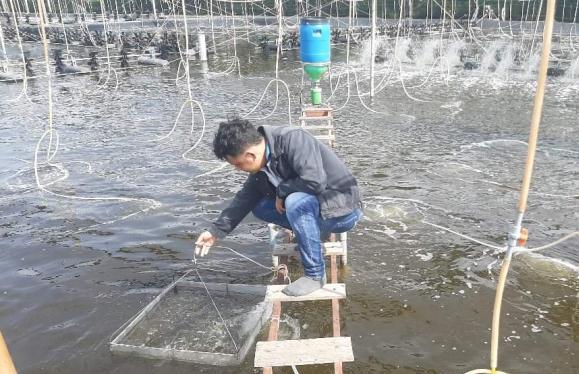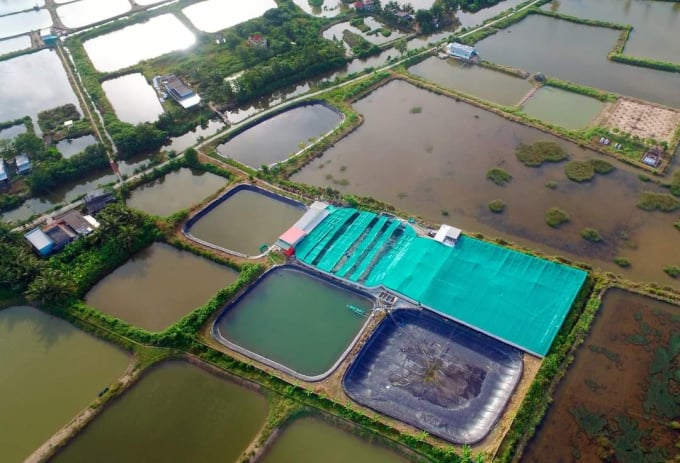May 21, 2025 | 10:03 GMT +7
May 21, 2025 | 10:03 GMT +7
Hotline: 0913.378.918
May 21, 2025 | 10:03 GMT +7
Hotline: 0913.378.918

Model of three-stage closed-loop shrimp farming demands little water change. Photo: Trong Linh.
Models of two-stage and three-stage high-tech intensive and super-intensive shrimp farming have been increasingly developed in recent years thanks to their efficiency.
Therefore, the areas of applying the models have been constantly expanded and particularly, more and more businesses have invested in them.
“The industrial shrimp farming model was still a new concept in Bac Lieu Province around 1998. Though locals did not know the technology but thanks to the favorable environment, they still succeeded in raising shrimps,” said Long Van Nghia, Deputy Director of the Management Board of Bac Lieu Shrimp Development Hi-Tech Industrial Park.
However, a few years later, shrimp farmers faced many difficulties caused by the polluted environment and constant diseases. They therefore had to innovate farming methods continuously, from extensive, improved extensive, semi-intensive to intensive farming, but all failed due to severe weather and diseases.
According to Nghia, the model of super-intensive shrimp farming in Bac Lieu began to thrive in 2016, even though it encountered many difficulties earlier. Up to now, super-intensive shrimp farmers can master over 90 per cent of technological processes and success rates.

Ngo Quoc Thai's closed-loop shrimp farming model in Long Dien Commune, Dong Hai District. Photo: Trong Linh.
However, in parallel with the success, environmental pollution in shrimp farming has broken out, becoming a dilemma for the agricultural sector in Bac Lieu province in the long run.
“The best solution is to improve the environment by raising shrimp with less water change, using many microbial products and thoroughly treating waste, from which the shrimp farming environment becomes safe, the farming process will cause less pollution and diseases could be handled. Stages from the input to the output could become stable to protect the environment and ensure that shrimps are clean,” Nghia said.
In shrimp farming, if new techniques are not improved, it will easily lead to backwardness because the aquaculture does not have a stable process. This year might be successful but next year will be different.
Through the process of research and practical application, Ngo Quoc Thai’s household in Long Dien Commune, Dong Hai District decided to use probiotics for the three-stage closed-loop model due to its advantages including little water change and more convenient control of disease management on shrimp.
Thai said that he rarely had to use antibiotics and chemicals during the rearing process under the closed-loop model. Especially, the water source is still guaranteed and reused when microbial products are used, eliminating the waste discharged into the environment, thereby safely managing diseases for farmed shrimp and other farming households.
To farmers practicing the three-stage intensive shrimp farming process, they should pay most attention to the first stage as post larvae are prone to shock after being transferred to a new environment from the hatcheries. When stocking, it is necessary to create conditions for shrimp to be less susceptible to heat shock, while balancing the salinity during feeding, daily care to changing water in the first stage.
Meanwhile, the biggest advantage of the three-stage closed-loop intensive shrimp farming model is disease management. If it is implemented properly, it is capable of controlling 90 percent of the disease. In the past, farmers raised shrimps in earthen tunnels depending on the natural environment. Currently, there are two distinct ways of raising shrimps – making a lot of water changes and rearing in a closed circulation model with little water change. However, each model has its own advantages.
If shrimps are reared in the model of much water change with dense stocking, the culture time is shorter while the growth rate is faster. However, this model has a risk of affecting the natural water source if too much water is supplied.
According to Thai, his family still chooses to keep a closed-loop culture, using biological products and raising a moderate density so the water will be changed very little, from 10 up to 20 per cent maximum.
Although the growth rate of shrimp is a bit slower, disease safety is greatly improved so sustainable profits will be obtained.
The important thing of the shrimp farming process with the use of probiotics is to create a good environment for the shrimp as there is no need to use antibiotics and toxic chemicals. More specifically, it is possible to reuse water without discharging it into the environment.

The closed-loop shrimp farming model ensures the quality of the water source and causes less environmental pollution. Photo: Trong Linh.
According to Long Van Nghia, Deputy Director of Management Board of Bac Lieu Shrimp Development Industrial Park, the process of industrial shrimp farming is divided into several stages. Therefore, the process of raising shrimps in each stage demands creativity to produce better products.
Currently, in the three-stage closed-loop shrimp farming process, the unit has created inventions.
The first is to improve the ponds to reduce labor costs, raw materials and electricity. The second is to improve the problem of environmental pollution by thoroughly treating 90 per cent of waste with a biogas system to serve domestic activities. Waste such as shrimp shells or manure is composted to make organic fertilizer for farming effectively.
“If probiotics is used successfully in the three-stage closed-loop shrimp farming model, the farmers could earn a profit that increases by 30 to 40 per cent,” Nghia said.
Specifically, a 500sq.m pond could harvest from 3.5 to 4 tons of shrimp/crop, meaning that 1ha of pond water will harvest from 200-250 tons of shrimp/ha/year (5 farming crops/year).
“A good farming crop with stable cost of materials and little use of chemicals could bring a profit of VND 150 million/pond/crop,” he added.
According to Luu Hoang Ly, Director of Bac Lieu Department of Agriculture and Rural Development, the province now has 23 companies, units and 650 households that are investing in super-intensive and 2-phase whiteleg shrimp farming.
At the same time, 9 enterprises have been selected to invest in the industrial park and estimates for the second phase of investment are being prepared, with an aim to implement the project "Building Bac Lieu into the center of the shrimp industry in the country”.
Translated by Phuong Ha

(VAN) Facing the threat of rabies spreading to the community, Gia Lai province urgently carries out measures to vaccinate dogs and cats on a large scale.

(VAN) Disease-free livestock farming not only protects livestock herds but also stabilizes production and livelihoods for many farmers in Tuyen Quang.

(VAN) Japan's grant aid project contributes to capacity building, promoting organic agricultural production, and fostering sustainable community development in Dong Thap province.

(VAN) For years, the CRISPR-Cas9 genome technology has been reshaping genetic engineering, a precision tool to transform everything from agriculture to medicine.

(VAN) Vietnam aims to become a 'leader' in the region in the capacity and managing effectively soil health and crop nutrition.
![Reducing emissions from rice fields: [Part 1] Farming clean rice together](https://t.ex-cdn.com/nongnghiepmoitruong.vn/608w/files/news/2025/05/05/z6509661417740_a647202949c539012a959e841c03e1d3-nongnghiep-143611.jpg)
(VAN) Growing clean rice helps reduce environmental pollution while increasing income, allowing farmers to feel secure in production and remain committed to their fields for the long term.
/2025/05/19/5136-1-144800_230.jpg)
(VAN) The Nghe An Provincial People's Committee has just approved the list of beneficiaries eligible for revenue from the Emission Reductions Payment Agreement (ERPA) in the North Central region for the year 2025.